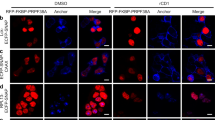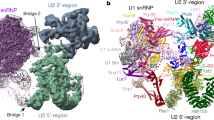Abstract
THE adenovirus L1 unit1 represents an example of an alternatively spliced precursor messenger (pre-mRNA) where one 5' splice can be joined to one of two alternative 3' splice sites, producing the 52,55K or the IIIa mRNAs (Fig. 1a). Efficient usage of the distal IIIa 3' splice site requires late viral protein synthesis and is therefore confined to the late phase of virus infection2–4. Here we show that, in extracts from uninfected cells, the classical SR proteins5, which are essential splicing factors5–7, inhibit IIIa pre-mRNA splicing by binding to an intronic repressor element and preventing recruitment of the U2 small nuclear ribonucleoprotein particle to the spliceosome. We further show that the viral repressor element has splicing-enhancer activity when appropriately placed in the pre-mRNA. Together, our results demonstrate that SR proteins function as activators or repressors of splicing depending on where on the pre-mRNA they bind.
This is a preview of subscription content, access via your institution
Access options
Subscribe to this journal
Receive 51 print issues and online access
$199.00 per year
only $3.90 per issue
Buy this article
- Purchase on Springer Link
- Instant access to full article PDF
Prices may be subject to local taxes which are calculated during checkout
Similar content being viewed by others
Author information
Authors and Affiliations
Rights and permissions
About this article
Cite this article
Kanopka, A., Mühlemann, O. & Akusjärvi, G. Inhibition by SR proteins of splicing of a regulated adenovirus pre-mRNA. Nature 381, 535–538 (1996). https://doi.org/10.1038/381535a0
Received:
Accepted:
Issue Date:
DOI: https://doi.org/10.1038/381535a0
This article is cited by
-
RBM20, a potential target for treatment of cardiomyopathy via titin isoform switching
Biophysical Reviews (2018)
-
A purine-rich element in foamy virus pol regulates env splicing and gag/pol expression
Retrovirology (2017)
-
Dynamic m 6 A modification and its emerging regulatory role in mRNA splicing
Science Bulletin (2015)
-
Diverse regulation of 3′ splice site usage
Cellular and Molecular Life Sciences (2015)
-
A complex network of factors with overlapping affinities represses splicing through intronic elements
Nature Structural & Molecular Biology (2013)
Comments
By submitting a comment you agree to abide by our Terms and Community Guidelines. If you find something abusive or that does not comply with our terms or guidelines please flag it as inappropriate.



